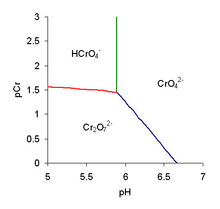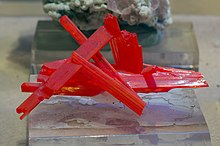Chromate and dichromate
| |||
| |||
| Names | |||
|---|---|---|---|
| Systematic IUPAC name
Chromate and dichromate | |||
| Identifiers | |||
| |||
3D model (
JSmol ) |
| ||
| ChEBI |
| ||
| DrugBank |
| ||
PubChem CID
|
|||
| UNII |
| ||
CompTox Dashboard (EPA)
|
| ||
| |||
| |||
| Properties | |||
| CrO2− 4 and Cr 2O2− 7 | |||
| Molar mass | 115.994 g mol−1 and 215.988 g mol−1 | ||
Conjugate acid
|
Chromic acid | ||
Except where otherwise noted, data are given for materials in their standard state (at 25 °C [77 °F], 100 kPa).
| |||
Chromate salts contain the chromate anion, CrO2−
4. Dichromate salts contain the dichromate anion, Cr
2O2−
7. They are
Chemical properties
Chromates react with
Acid–base properties

In aqueous solution, chromate and dichromate anions exist in a chemical equilibrium.
- 2 CrO2−
4 + 2 H+ ⇌ Cr
2O2−
7 + H2O
The predominance diagram shows that the position of the equilibrium depends on both pH and the analytical concentration of chromium.[notes 1] The chromate ion is the predominant species in alkaline solutions, but dichromate can become the predominant ion in acidic solutions.
Further condensation reactions can occur in strongly acidic solution with the formation of trichromates, Cr
3O2−
10, and tetrachromates, Cr
4O2−
13.
The hydrogen chromate ion, HCrO4−, is a
- HCrO−
4 ⇌ CrO2−
4 + H+; pKa ≈ 5.9
It is also in equilibrium with the dichromate ion:
- 2 HCrO−
4 ⇌ Cr
2O2−
7 + H2O
This equilibrium does not involve a change in hydrogen ion concentration, which would predict that the equilibrium is independent of pH. The red line on the predominance diagram is not quite horizontal due to the simultaneous equilibrium with the chromate ion. The hydrogen chromate ion may be protonated, with the formation of molecular chromic acid, H2CrO4, but the pKa for the equilibrium
- H2CrO4 ⇌ HCrO−
4 + H+
is not well characterized. Reported values vary between about −0.8 and 1.6.[4]
The dichromate ion is a somewhat weaker base than the chromate ion:[5]
- HCr
2O−
7 ⇌ Cr
2O2−
7 + H+, pK = 1.18
The pK value for this reaction shows that it can be ignored at pH > 4.
Oxidation–reduction properties
The chromate and dichromate ions are fairly strong
- Cr
2O2−
7 + 14 H+ + 6 e− → 2 Cr3+ + 7 H2O ε0 = 1.33 V
In alkaline solution chromium(III) hydroxide is produced. The
- CrO2−
4 + 4 H
2O + 3 e− → Cr(OH)
3 + 5 OH−
ε0 = −0.13 V
Applications

Approximately 136,000 tonnes (150,000 tons) of hexavalent chromium, mainly sodium dichromate, were produced in 1985.[8] Chromates and dichromates are used in chrome plating to protect metals from corrosion and to improve paint adhesion. Chromate and dichromate salts of heavy metals, lanthanides and alkaline earth metals are only very slightly soluble in water and are thus used as pigments. The lead-containing pigment chrome yellow was used for a very long time before environmental regulations discouraged its use.[7] When used as oxidizing agents or titrants in a redox chemical reaction, chromates and dichromates convert into trivalent chromium, Cr3+, salts of which typically have a distinctively different blue-green color.[8]
Natural occurrence and production

The primary chromium ore is the mixed metal oxide chromite, FeCr2O4, found as brittle metallic black crystals or granules. Chromite ore is heated with a mixture of calcium carbonate and sodium carbonate in the presence of air. The chromium is oxidized to the hexavalent form, while the iron forms iron(III) oxide, Fe2O3:
- 4 FeCr2O4 + 8 Na2CO3 + 7 O2 → 8 Na2CrO4 + 2 Fe2O3 + 8 CO2
Subsequent leaching of this material at higher temperatures dissolves the chromates, leaving a residue of insoluble iron oxide. Normally the chromate solution is further processed to make chromium metal, but a chromate salt may be obtained directly from the liquor.[9]
Chromate containing minerals are rare.
Toxicity
See also
Notes
- ^ pCr is equal to the negative of the decimal logarithm of the molar concentration of chromium. Thus, when pCr = 2, the chromium concentration is 10−2 mol/L.
References
- ISBN 978-0-08-037941-8.
- S2CID 231808339.
- ISBN 978-0-08-037941-8.
- ^ IUPAC SC-Database. A comprehensive database of published data on equilibrium constants of metal complexes and ligands.
- .
- ISBN 0-12-352651-5.
- ^ ISBN 978-0-87179-752-0.
- ^ ISBN 3527306730.
- ISBN 978-0-87335-233-8.
- ^ "Mines, Minerals and More". www.mindat.org.[page needed]
- carcinogenicityof chromium (VI) compounds. Chromium (VI) compounds cause cancer of the lung. Also positive associations have been observed between exposure to chromium (VI) compounds and cancer of the nose and nasal sinuses. There is sufficient evidence in experimental animals for the carcinogenicity of chromium (VI) compounds. Chromium (VI) compounds are carcinogenic to humans (Group 1).






